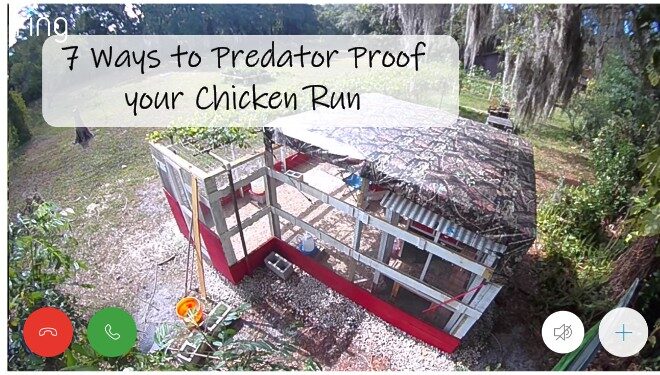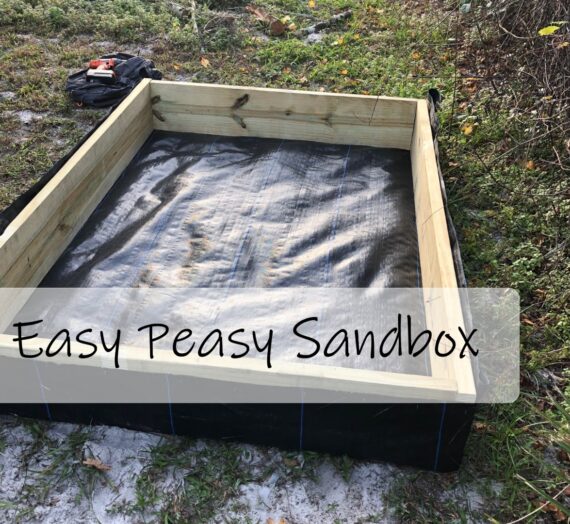I am not sure if you have a Tractor Supply Store near you, or if you have a local store that makes a big deal about chickens in the spring.. but there is a thing called “Chick Days” in the spring where an influx of chicks are sold and everyone looses their mind. Like crowding the cages and going chick crazy.
We were easily sucked into this madness as COVID19 quarantine days started around the same time as Chick Days this year. Why not? We have been talking about getting chickens for so long – so we jumped in. You can read about our journey of becoming chick owners or how we built our chick brooder out of a dog crate. But today I am going to talk to you about the measures we took to make sure that the chicken run we were building was as protected as possible!


This post may contain affiliate links. For more information, visit my Disclosure page
Being predator proof was our #1 goal. No matter where we put it, how many chickens we owned, we wanted to make sure that we felt confident in their safety. This meant a lot of research!
I joined every Facebook group I could find, pinned every coop / run tutorial I could, and continued to read until I had a list of must haves! I feel like I learned from hundreds of years of experience because with all of the tips came the sad reasons and stories of why someone changed their setup.
So this brings me to a condensed list of the top 7 things we did to protect our girls. As you go through this list – please keep in mind to truly protect your flock you need to know what predators you are up against and tailor your list based off of them. We live in Central Florida and the main predators we have are: Raccoons, Owls, Hawks, and my own Dogs.
1. Hardware Cloth Bottom Layer
The very first step we took after picking our placement of our run was to dig out several inches down, and place a layer of hardware cloth on the ground. This should extend about 1 foot outside of where the walls of your run will be, and any overlapping should be secured together with hog rings or wire.
You will have predators that dig to get in. When they dig and hit the strong hardware cloth they will be discouraged. Having it line the entire bottom of your run will stop them from digging further out and coming up through the middle. You can then replace the dirt on top of it, so the chickens are unaware.
2. Wood Panel Around the Bottom & Roost Areas
This tip wasn’t a common one but was the one that made me feel most comfortable in my design. Raccoons are plenty around here, and they have little hands that reach very far! One common cause of loss in a chicken run/coop that I read was a raccoon reaching its arm in, and grabbing your chicken while they are sleeping or just too close to the outside. The most disturbing part about this is that sometimes they don’t even get your chicken out of the wire.. they just snap its neck as if its for sport.

In order to prevent this – we added a couple of feet of wood paneling around the outside walls. On the wall that we have our main roost, we added full wall panels. This way the chickens can confidently sleep, and so can I.
3 . Rocks Around the Paremeter
Another layer of protection from digging was to put a pretty deep layer of rocks around the entire run. We bought the rocks from a local landscaping business. It was fairly inexpensive and easy to throw down.

4. Shade and Protection from Above
Hawks are a pretty common threat – they swoop down and can be strong to rip through chicken wire and sometimes they can rip through hardware cloth too. We did put hardware cloth on the top of our run, but strategically built our run underneath an existing grape vine to add even more protection/shield from these predator birds.
It also doubles as shade and a food source when the leaves fall into the run. You should see it happen.. its like a game of hungry hungry hippos up in there! Sometimes your chickens will convince you to give them a boost!
5. Wood Covering Hardware Cloth Ends
I have seen many posts about animals ripping through hardware cloth and the chicken owner confused. Most of them I see happen where the hardware cloth overlaps, or there the end meets a new panel of hardware cloth. What some are doing, and we adopted, was using wood screwed to sandwich together on both sides of the panel ends. The screws strengthen the overlap and the wood stops little racoon hands from grabbing the end of the hardware cloth and pulling.
6. Placing the Coop Inside the Run
Our coop was a prefab one bought from Tractor Supply Store. Honestly- I just didn’t want to deal with building it. It seemed complicated and I was on a 5 week deadline since we already had our chicks. Let’s be honest- these companies are going to make their coops as cheap as they can, and you need to realize that its not Fort Knox.

Our original plans had our coop attaching to the run on the outside. After thinking longer and harder about this decision, we decided to expand our run space and simply put the coop inside it. This way the predators have to break into two different structures to get to my girls at night.



7. Motion Camera
Ok this one may be overkill but I am totally loving it. Many posts were about someone accidently leaving the run or coop open. With a wireless Ring Spotlight camera, you can easily check this any time of day or night. It also has a motion sensor that will turn a bright light on and scare away any night crawlers while it alters you that there is motion.
If I only had my camera for the sheer joy of checking in on the girls, it is worth it!

So far we have had no scares or worries about their well being. Its amazing how stressed I was but taking the measures above really calmed my nerves and in the off chance that we have an accident or a predator break in- I know that we took every step we could to protect them. If you have additional tips or even questions, please share in the comments below!















Quick (DIY) Crate Chicken Brooder - Propagate Happiness
[…] this read? Check out related blog posts:Predator Proofing Our First Chicken RunThe Why and How to using Sand in your Chicken […]
The 'Why' and 'How' to using Sand in your Chicken Run - Propagate Happiness
[…] this read? Check out related blog posts:Predator Proofing Our First Chicken RunQuick (DIY) Crate Chicken […]
Officially Chicken Owners! - Propagate Happiness
[…] this read? Check out related blog posts:Predator Proofing Our First Chicken RunQuick (DIY) Crate Chicken […]